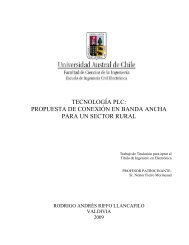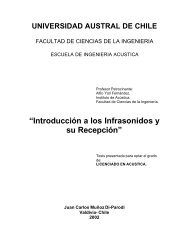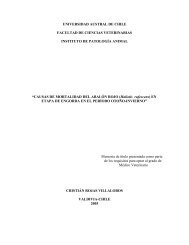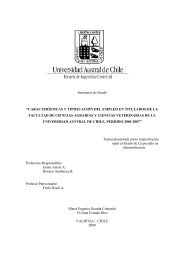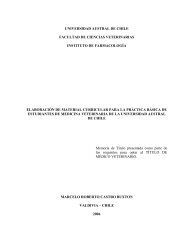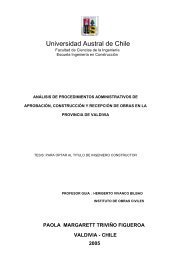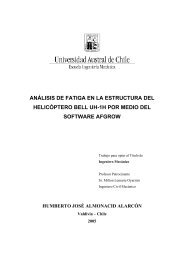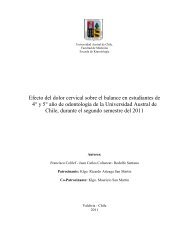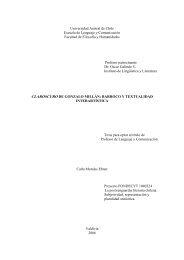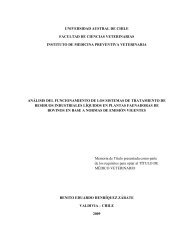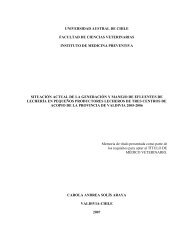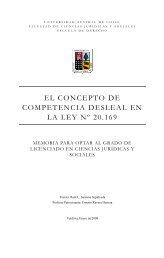Diversidad y control biológico de insectos - CyberTesis UACh ...
Diversidad y control biológico de insectos - CyberTesis UACh ...
Diversidad y control biológico de insectos - CyberTesis UACh ...
Create successful ePaper yourself
Turn your PDF publications into a flip-book with our unique Google optimized e-Paper software.
GENETIC DIVERSITY OF Beauveria bassiana (BALSAMO) VUILLEMIN IN<br />
CHILE REVEALED BY A NUCLEAR GENE SEGMENT SEQUENCING.<br />
Luis Devotto 1* , Stephen A. Rehner 2 , M. Mén<strong>de</strong>z 3 and A. France 4 .<br />
1 Escuela <strong>de</strong> Graduados, Facultad <strong>de</strong> Ciencias Agrarias, Universidad Austral <strong>de</strong> Chile,<br />
Valdivia, Chile.<br />
2 USDA, Agricultural Research Service, Insect Bio<strong>control</strong> Laboratory, BARC-West,<br />
Beltsville, MD, USA.<br />
3 Instituto <strong>de</strong> Nutrición y Tecnología <strong>de</strong> los Alimentos, Universidad <strong>de</strong> Chile, Santiago,<br />
Chile, Av. El Líbano 5524, Santiago, Chile.<br />
4 Departamento <strong>de</strong> Producción Vegetal, Centro Regional <strong>de</strong> Investigación Quilamapu,<br />
Instituto <strong>de</strong> Investigaciones Agropecuarias (INIA), Chile. Avda. Vicente Mén<strong>de</strong>z 515,<br />
Chillán, Chile.<br />
* Current address: Departamento <strong>de</strong> Producción Vegetal, Centro Regional <strong>de</strong> Investigación<br />
Quilamapu, Instituto <strong>de</strong> Investigaciones Agropecuarias (INIA), Chile. l<strong>de</strong>votto@inia.cl<br />
Summary.<br />
The genetic structure of seven Chilean putative populations of the entomopathogenic<br />
fungus Beauveria bassiana (Balsamo) Vuillemin was investigated by sequencing a ca.<br />
1400 bp nuclear gene fragment named B locus. Ninety seven B. bassiana sensu lato<br />
isolates were inclu<strong>de</strong>d, which have been previously collected accross the country, most of<br />
them from soil using the Galleria mellonella baiting method. Phylogenetic and<br />
<strong>de</strong>mographic approaches were adopted in a sequential fashion to analyze the resulting data<br />
set. The 97 isolates were collapsed to 20 haplotypes. Neighbour-joining and maximum<br />
parsimony trees revealed 9 well supported cla<strong>de</strong>s. Only one cla<strong>de</strong> inclu<strong>de</strong>d isolates<br />
collected in the same locality and they correspon<strong>de</strong>d to Eastern Island isolates. The<br />
remaining cla<strong>de</strong>s gathered isolates from very different geographical origin, including<br />
isolates thousands of kilometers apart. Seven populations were <strong>de</strong>fined a priori based on<br />
ecological and climatic conditions. The AMOVA analysis revealed a significant but limited<br />
support for the proposed structure. One isolate, co<strong>de</strong>d QU-B931, is a good potential<br />
candidate for biological pest <strong>control</strong>. This isolate was distinguishable from the rest of the<br />
17



